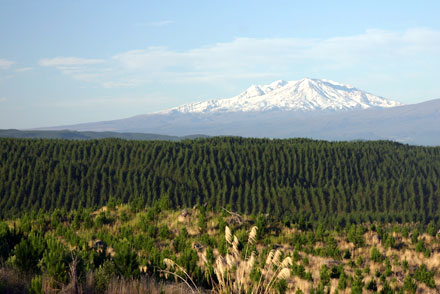
The last pine trees have been felled in a major Hawkes Bay conservation project in New Zealand that aims to convert a 4000-hectare pine plantation back to regenerating native forest. Source: Timberbiz
More than 3500 hectares of the Maungataniwha Pine Forest have now been logged since 2006 and are now in the process of being re-converted back to native forest by land owner Simon Hall, Chairman of the Forest Lifeforce Restoration Trust.
The land lies adjacent to the Maungataniwha Native Forest, a 6120-hectare swathe of New Zealand bush straddling the ridge system between the Te Hoe and Waiau Rivers in northern Hawkes Bay, bordered to the north by Te Urewera National Park and to the west by the Whirinaki Conservation Forest.
The conversion of the Maungataniwha Pine Forest is the largest project of its kind in New Zealand. It is the Forest Lifeforce Restoration Trust’s biggest and most expensive single undertaking.
The FLR Trust has gradually been taking over control of the block from Matariki Forests, which has held the licence to log the pine.
The aim is to re-vegetate the area with indigenous forest. There is sufficient native species seed in the soil to enable natural regeneration but the major challenge, and cost, is the elimination of regenerating pine seedlings which crowd out the slower growing native forest species.
The grasses are the first to take hold; native species like hookgrass and toetoe. Then shrubs or small trees like mahoe and wineberry. These are followed by mountain cabbage-tree, kanuka and native fuschia.
Once these species have re-colonised the land the stage is set for larger stuff such as red and silver beech.
Native birds such as kereru and silvereyes play a vital role in the regeneration. It takes a decade to clear logged land of wilding pines completely and to get it to the point where it can be described as fully regenerated.
During this time the land is nurtured, treated and monitored by the FLRT to ensure that the species they expect to appear do so.
About a third of the area, 1400 hectares, can now be described as clear of regenerating pines and successfully regenerated with native species.
The Trust, which was established in 2006 to provide direction and funding for the restoration of threatened species of native fauna and flora in forests within the Central North Island, uses a mix of aerial spraying and manual clearance methods.
DOC is interested in the land stewardship methods and spray mix used by the Trust to encourage the growth of native plants while inhibiting these ‘wilding’ pines.
“Conservation in New Zealand is no longer the preserve of government agencies,” said Trust Chairman Simon Hall. “The job’s too big and complex. Everyone has a role to play, ideally working together as much as they can.
“We’ve been delighted with, and very grateful for, the support of DOC. It’s been vital to helping us get the job done.”
Mr Hall said it was the end of an era and that the pine forest had provided livelihoods for many people, from planting it to managing and harvesting it. But he was pleased now to be able to start completing the process of returning it to its natural state.





